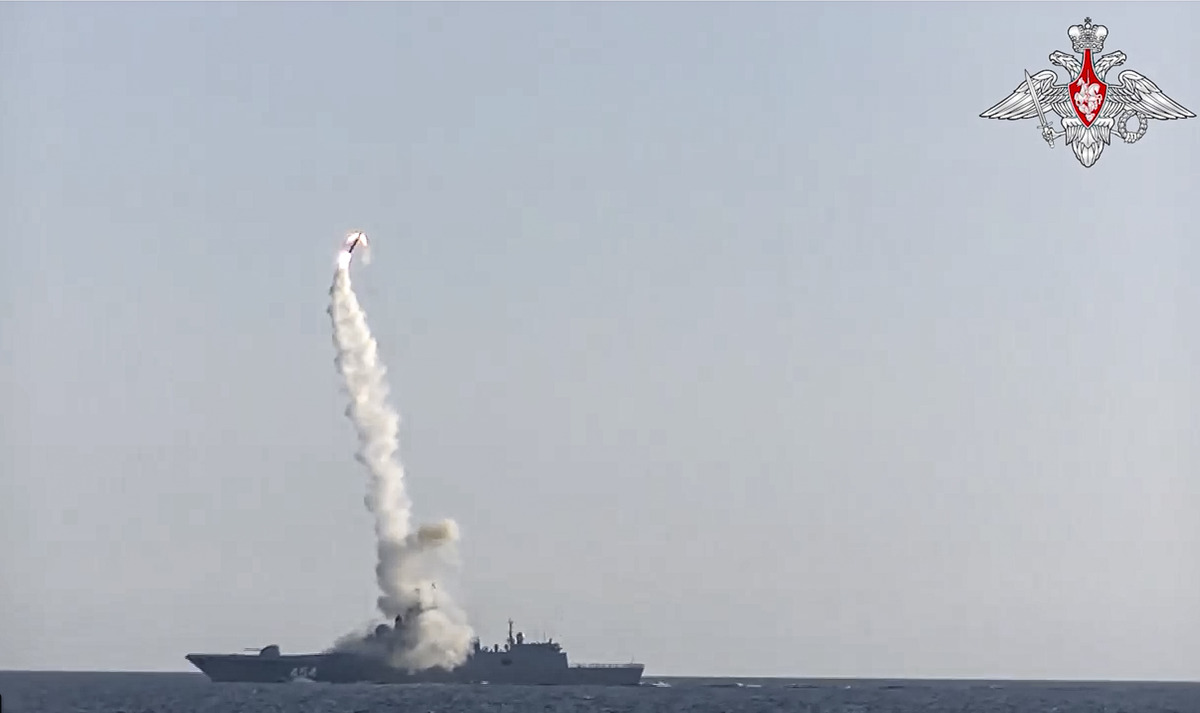
The U.S. and U.K. are moving ahead with the technology underpinning several hypersonic weapons development programs.
Why It Matters
Western countries have trailed behind Russia and China in developing hypersonic weapons, expensive and difficult-to-produce systems able to travel upwards of five times the speed of sound, or Mach 5.
The missiles, which can be launched from the ground, air or sea, are able to maneuver mid-flight, making them extremely hard to detect, track or intercept.
The U.S. and U.K. do not yet have operational hypersonic weapons, although several U.S. programs have been working towards hypersonic boost-glide systems and cruise missiles.
“The U.S., Russia, and China are in an arms race over hypersonics, and nobody wants to drop out,” journalist and technology expert David Hambling told Newsweek.
Russian Defense Ministry Press Service via AP
What To Know
U.S. aerospace company, Rocket Lab, said in a statement on Monday that its launch vehicle, the Hypersonic Accelerator Suborbital Test Electron or HASTE, had been picked for hypersonic test launches in programs run by the U.S. and the U.K.
This announcement is more about the testing of new technology and support for hypersonic programs rather than the weapons development side, Hambling said.
It will “enable the U.S. to launch hypersonic glide vehicles and other payloads and see whether they fly as intended,” Hambling told Newsweek.
A hypersonic glide vehicle is a warhead or missile launched into space by a rocket and then gliding through the upper atmosphere at hypersonic speeds.
“This is part of a much longer-term effort to build a hypersonics technology base, much less glamorous than a shiny new missile but more strategically important,” Hambling said.
The U.S. Air Force selected the California-headquartered company for what is known as an “indefinite delivery-indefinite quantity” (IDIQ) contract worth $46 billion, Rocket Lab said. This type of contract is used when the exact timing, delivery and costs aren’t clear upfront.
The company said the British Defense Ministry had picked Rocket Lab for its own Hypersonic Technologies & Capability Development Framework, worth roughly $1.3 billion, to quickly develop hypersonic capabilities for the U.K.
Rocket Lab will now be able to bid on providing services, testing and technology for London’s hypersonic programs, the company said.
The HASTE launch vehicle “can deploy technologies at speeds of more than 7.5km per second to test air-breathing, glide, and ballistic payloads, as well as technologies to re-enter Earth’s atmosphere from space,” the company added.
The British government said earlier this month that scientists had completed testing on an air-breathing engine for an in-development “cutting-edge” hypersonic cruise missile. The scientists carried out more than 200 tests at various hypersonic speeds at the NASA Langley Research Center in Hampton, Virginia, the defense ministry said.
The U.S. Air Force Research Laboratory, a scientific research arm of the military, was involved in the “extensive” tests over six weeks, London said.
Britain’s Defense Secretary John Healey said these tests were a “milestone moment on hypersonics research,” adding it was a “crucial area where we are working in lockstep with the United States.”
The U.K. had said in November that it was accelerating “crucial” hypersonic missile development as part of AUKUS, the trilateral security agreement between the U.S., U.K. and Australia.
The U.S. Air Force in 2023 scrapped its hypersonic Air-launched Rapid Response Weapon (ARRW), and earlier this month, the U.S. Navy stopped its plans for the Hypersonic Air-Launched Offensive Anti-Surface Warfare (HALO) missile, an air-launched and air-breathing hypersonic cruise missile.
A Navy spokesperson told Naval News the development was axed in fall 2024 “due to budgetary constraints that prevent fielding new capability within the planned delivery schedule.”
“Flight at Mach 5 in the atmosphere is very much more challenging than flight at lower speeds,” Hambling said. “Any glitch spells disaster.”
What People Are Saying
Rocket Lab founder and CEO, Sir Peter Beck, said in the Rocket Lab press release: “The ability to contribute toward the collective security of the United States and the United Kingdom across both of these important programs is a proud moment for the HASTE team, and a demonstration of Rocket Lab’s commitment to lead from the front when it comes to innovative and unique solutions for hypersonic technology development.”
Hambling told Newsweek: “The amount being spent speaks of a major commitment to hypersonics.”
What’s Next
As the U.S. and U.K. accelerate development under the AUKUS alliance, more launches using HASTE are anticipated in the coming months. These efforts aim to build out a robust hypersonics technology base rather than focus immediately on deployment-ready weapons. Progress will depend not only on technical success but also on consistent funding, especially as budgetary constraints have recently led to the cancellation of major U.S. hypersonic missile programs.
